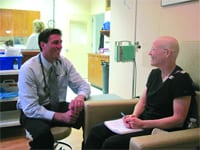Bright Idea Early Detection Can Stop Deadly Melanoma
Steve Fine turned a tragedy into a chance to prevent more of them.
“My son died from melanoma in 1998. He was 26,” said Fine, who lives in Peabody. “After going through that horrible experience, we realized that most deaths from melanoma could have been prevented by early self-detection. So, with that in mind, we started the Melanoma Education Foundation.”
That 10-year-old organization, which Fine still leads today, targets teenagers through middle and high schools with educational programs that explain what melanoma is, why it’s so dangerous if undetected, and how to recognize it. The program, backed up by the Web site skincheck.org, has been adopted by 875 schools in New England and across the country.
Why is that number important? Simply because melanoma, the most common form of skin cancer, is one of the easiest cancers to deal with if it’s diagnosed early, yet one of the most unsparing if it’s not.
“Early detection is the key to success,” said Dr. Sean Mullally, an oncologist and hematologist with Northampton Oncology-Hematology Associates. “There is no cure for stage 4, or metastatic, melanoma, and there hasn’t been a new, approved drug for advanced melanoma in more than 30 years. It’s an especially difficult tumor to treat.”
Fortunately, it’s the only cancer that can be detected visually in its earliest stages, if one knows what to look for (more on that later). It’s knowledge that, quite frankly, can save lives.
Debi Facchetti of Wilbraham, school development director of the Melanoma Education Foundation (MEF), said one mother called her just two months ago about a mark that her 15-year-old son had brought to her attention.
“He had something on the back of his leg, and he told her, ‘Mom, this has been there eight or nine months,’” said Facchetti said, adding that the youth didn’t think anything of it, but saw the MEF video on melanoma that day and started thinking.
“I told her, ‘we’re not doctors, but listen — please go to the dermatologist and get it looked at,’” Facchetti continued. “Two weeks later, she called us back, and she was crying, saying, ‘thank you, thank you, you saved my son with this information. He never would have come to me with this.’ We triggered something in him — a worry, a fear, but a good fear — and they were able to catch it, and now they have him monitored. She would have lost her son had it gone on any longer.”
Check It Out
Other such stories are being told all the time. For instance, when Cooley Dickinson Hospital recently conducted its annual skin-cancer screening clinic, it tested 78 people, and 26{06cf2b9696b159f874511d23dbc893eb1ac83014175ed30550cfff22781411e5} of them were referred for follow-up care due to a positive finding. It’s not unreasonable to assume that some of those might not have been tested had the hospital not announced a screening event.
The MEF’s educational program consists of a 45-minute lesson including a DVD and handouts. Fine says the group would like to grow and gain more of a national presence, but until it has the resources to visit schools in person, this is the most effective way to deliver the message.
Students learn about the stages and risk factors of melanoma. Specifically, stage 1 melanoma is at the skin level, and stage 2 affects tissue beneath the skin. Stage 3 means it has spread to the lymph nodes, and at stage 4, it has reached the organs, and is invariably fatal, usually quickly.
The most obvious risk factor, Mullally said, is sun exposure — particularly intermittent, high-dose exposure, like that of a sunbather or, worse, someone using a tanning bed.
Facchetti recalled her concern about a friend who frequented tanning beds on a regular basis and was not likely to alter this habit, despite warnings about how such exposure might affect the skin long-term. “I said, ‘if you don’t have the willpower to change your lifestyle, could you see a dermatologist once or twice a year?’” She agreed to do just that.
“It just takes 20 minutes,” Facchetti said. “I know it’s a hassle to make an appointment and then wait in the waiting room. But if it might save your life, who cares?”
Other reported risk factors include exposure to the contaminant PCB, smoking, and the long-term use of oral contraceptives. But Mullally stressed that the disease does not discriminate by age or gender, and it kills more than 8,650 Americans per year, on average.
He explained that, when it comes to examining a mole or birthmark, they should follow a series of questions that correspond to A-B-C-D-E.
“A stands for asymmetry,” he said, noting that, the more symmetrical a mark is, the less chance there is of cancer. “Then, we ask, is there border irregularily? Is there color variation? Is the diameter greater than 6 millimeters? And the E stands for enlargement or evolution — a change in the color, shape, or size.”
Listen to the Boss
Facchetti, like Fine, has her own family story of how she wound up advocating for melanoma awareness, but that story has a happier ending.
It began when she lived in New Jersey, and her husband’s boss noticed that the mole on his face looked a bit different than usual, and encouraged him to see a doctor. After three months of nagging, he finally made the appointment, but the doctor told him it was fine.
But his boss remained unconvinced and told him he should see a dermatologist. He did so, three months after seeing the first doctor, but was again told the mark was benign. So he went home, thinking that was that.
But his boss still wouldn’t leave him alone, and goaded him to get a second opinion. He eventually did, and that dermatologist was also initially skeptical of any danger. But, Facchetti said, “he asked, ‘do you want it off anyway? We can take it off and get it tested.’ So he did.”
The next time Facchetti’s husband heard from the specialist — three days after the birth of their first child — he was told he had stage 2 melanoma, and he needed to get to the hospital immediately, where doctors performed surgery to remove cancerous tissue under the skin and his lymph nodes. He made a full recovery — but delaying treatment much longer might have been devastating.
Facchetti understands that it sounds odd to tell that story right after encouraging people to see a dermatologist if they see something out of the ordinary, since both specialists in her husband’s case initially suspected no problem. But she said the episode simply reinforces the importance of being educated and trusting one’s own instincts. After all, mole removal and testing is an easy process, she said; why not demand to have it done, just for the peace of mind?
“Don’t put all your faith in one dermatologist; see a different one if you don’t like the answer,” she said. “The idea is to empower yourself. If you see something on your skin that you know was not there or has changed, get it tested.”
After all, she said, when dealing with a disease that can become fatal so quickly, it’s better to be sure — a sentiment which surely rings true for that mother who called two months ago.
“I get chills when I think of that phone call,” Facchetti said, adding that such moments are worth all the time MEF members spend handing out information in front of colleges, libraries, and supermarkets.
“I’d do it 23.99 hours a day if that’s what it would take to save one life,” she told The Healthcare News. “I don’t know how many we’ve saved, but it feels great knowing we’ve saved one. I almost lost my husband, and Steve lost his son, and if I can help prevent someone else from going through that anguish, that means everything to me.”
Hopes Are High
Hope may be on the horizon for those diagnosed in the future with late-stage melanoma. Last month in Chicago, at the annual meeting of the American Society of Clinical Oncology, researchers unveiled the results of a trial of a drug called ipilimumab, which Bristol-Myers Squibb hopes the U.S. Food and Drug Administration will approve soon.
In the double-blind trial, 676 patients with stage 4 melanoma were administered either the drug (known casually as ‘ipi’) or a placebo. Those getting ipi lived on average for 10 months compared to six months for those not getting it.
But that average doesn’t tell what actually happened. Specifically, in between 20{06cf2b9696b159f874511d23dbc893eb1ac83014175ed30550cfff22781411e5} and 30{06cf2b9696b159f874511d23dbc893eb1ac83014175ed30550cfff22781411e5} of patients getting the drug, the result was dramatic, in that the metastasized cancer either dramatically reduced in size or simply disappeared. The remaining 70{06cf2b9696b159f874511d23dbc893eb1ac83014175ed30550cfff22781411e5} to 80{06cf2b9696b159f874511d23dbc893eb1ac83014175ed30550cfff22781411e5} of patients had no response at all. Doctors don’t yet know how to predict which patients will respond to ipi, but the prospect of curtailing up to 30{06cf2b9696b159f874511d23dbc893eb1ac83014175ed30550cfff22781411e5} of melanoma deaths per year — well, that’s almost 3,000 lives saved annually in the U.S. alone.
“The results of the study showed this new drug to be very effective and exciting,” Mullally said.
But until a drug is developed that can effectively treat all melanoma cases, early detection will continue to be key, and that means education — and the ongoing work of organizations like the MEF.
“You can reach kids much more effectively when they’re younger,” Fine said. “They’re a more captive audience in high school. And when they leave their teenage years and enter their early 20s, their vulnerability to melanoma jumps enormously. So we felt that the best time to reach them was before they graduated from high school.”
Even directing such a program at college students isn’t as effective, Facchetti said, noting that they tend to be preoccupied with many more issues, and students receiving advice on melanoma during the college years aren’t as likely to retain it and follow up with self-checks as those who heard the message earlier.
Facchetti’s husband used his experience as a wakeup call. “He’s totally changed his routine,” she said. “He started eating better, exercising more, and he’s more in tune with his body.” And blessed, apparently, to have once worked for a very stubborn boss.
As for Fine, he’s gratified to be involved in an effort to avert tragedies like the one he lived through.
“Having gone through the experience of losing someone I love very much to this, I don’t want to see it happen to other people,” he said. “It’s so easy to treat if you just become aware of what it is and how to find it early.”
That’s an idea as bright as the sun.



Comments are closed.